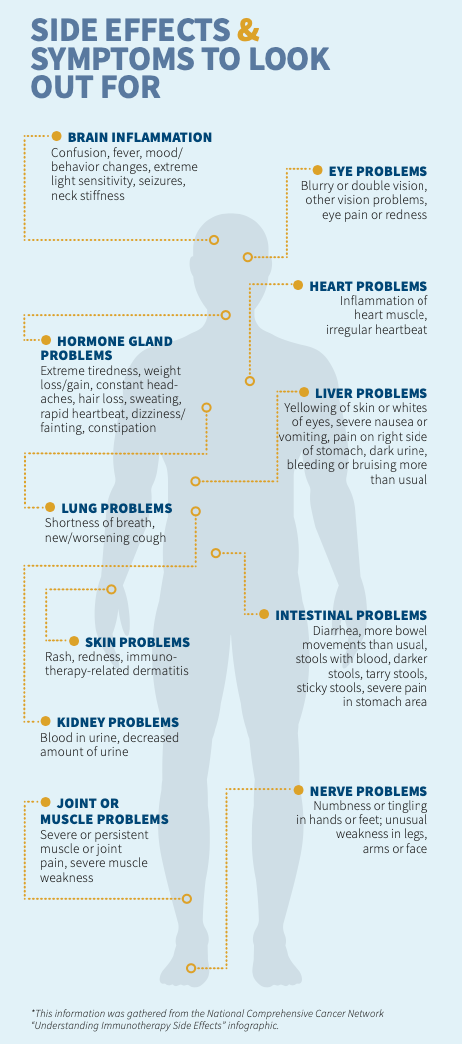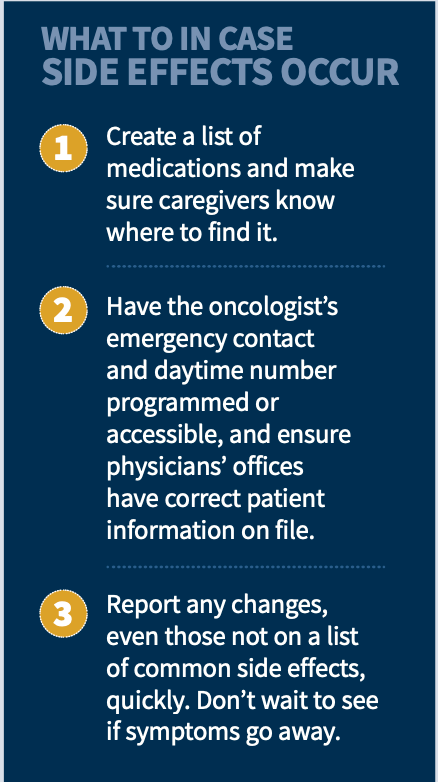Publication
Article
CURE
Act Fast: Side Effects of Immunotherapy
Author(s):
Experts urge patients to stop playing the wait-and-see game: There’s no ‘playbook’ for immunotherapy-related toxicities, and side effects can be managed if caught early.
Advancements in the immune checkpoint inhibitor space have given some patients a new treatment option for cancer outside traditional chemotherapy or surgery options. Currently, there are seven inhibitors approved by the Food and Drug Administration: Yervoy (ipilimumab), Tecentriq (atezolizumab), Bavencio (avelumab), Libtayo (cemiplimab-rwlc), Imfinzi (durvalumab), Opdivo (nivolumab) and Keytruda (pembrolizumab). With these immunotherapies, however, come the possibility of side effects, and according to experts, it’s of the utmost importance that patients are aware of them.

Mild side effects can occur in 30% to 50% of patients, whereas serious side effects occur in less than 5%, according to the National Comprehensive Cancer Network. “Typically, I frame it such as that unlike chemotherapy, which is a poison to both good and bad cells, the immunotherapy is working to boost the patient’s own immune system to detect and get rid of the cancer cells,” said Bobbie Khan, a clinical nurse coordinator at Georgetown Lombardi Comprehensive Cancer Center and MedStar Georgetown University Hospital in Washington, D.C., on educating patients. Sometimes, Khan explained, the immune system is pushed into hyperdrive and begins to attack healthy organs and tissues. This often leads to inflammation in normal tissue including organs that can lead to the side effects and toxicities of immunotherapy.
Side effects can include encephalitis (brain inflammation), hormone gland problems (such as thyroid abnormalities), pneumonitis (lung inflammation), kidney inflammation, skin irritations or rashes, colitis (large bowel inflammation), hepatitis (liver inflammation), nerve problems, eye problems, and myocarditis or arrhythmia (heart problems). Symptoms of these side effects can show up as fever, yellowing of the skin, diarrhea, shortness of breath, worsening cough and muscle weakness, among others. Most of the side effects can be reversed by specific treatments.

“Very rarely, (immunotherapy) can cause very devastating side effects that are refractory to treatment, such as inflammation in the brain,” noted Dr. Aiwu Ruth He, an associate professor of medicine at Georgetown Lombardi Comprehensive Cancer Center and Georgetown University Medical Center. Although most side effects are sudden and resolved in a matter of days to weeks with or without treatment, toxicities can last for months or years.
According to Khan, who works on He’s team, the most important step for patients — besides recognizing their symptoms — is to call their oncologist on first notice. If patients don’t call right away, it can “create a cascade of effects in the body that are difficult to control once the dominoes start falling,” she emphasized. Another important point to recognize is that side effects can show up during or after immunotherapy and most often occur further into treatment.
Dr. Patrick Ott, clinical director of the Melanoma Center at Dana- Farber Cancer Institute and associate professor of medicine at Harvard Medical School in Boston, said he’s seen patients develop toxicities after being on immunotherapy for over a year. “It would be unusual if a patient starts immunotherapy and then after a couple of days or even after a week or two, they’re already having the toxicities,” he explained. “More commonly, they are on the treatment for four or five, six weeks, and then that’s when the onset of these toxicities occurs. Sometimes it could be many months into the treatment.”
Ott says side effects often affect only one system, but not always. “There’s no playbook,” he said.
Treating Side Effects and Toxicities of Immunotherapy
Treatment of side effects and toxicities often requires immunosuppressive drugs such as corticosteroids. Sometimes additional steroids or combination therapies are needed, depending on the severity of the side effect. In order to treat the side effects, patients have to take a pause from their immunotherapy treatment, which may cause worry about how that will affect outcomes. “When we give corticosteroids, it actually does not seem to impact the efficacy of the treatments,” Ott explained. “We have many patients who have their treatment stopped or held because of the toxicity, but the cancer actually still continues to respond, even off treatment.”
Ott noted that tinkering with doses has been shown to make a difference, particularly when checkpoint inhibitors are used in combination, such as Yervoy and Opdivo. For example, lowering the dose of Yervoy made the combination less toxic, particularly in lung cancer, where the doses commonly used in melanoma could not be tolerated. “Yervoy and its dosing made a pretty fundamental impact on the toxicity,” he said.
In instances where a side effect doesn’t respond to an immunosuppressant, He said she will often perform a biopsy to see if there are specific immune cells that a different immunosuppressant can target. “Normally, we don’t do it unless we are really puzzled about what has caused (the side effect) or it has not responded to the initial intervention,” He noted.
For more news on cancer updates, research and education, don’t forget to subscribe to CURE®’s newsletters here.





